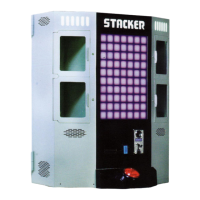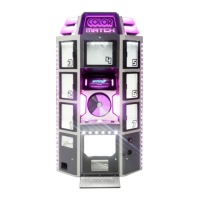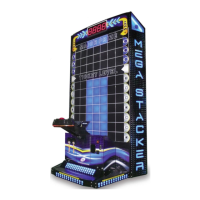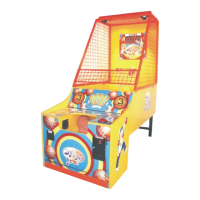Do you have a question about the LAI Games MEGA STACKER and is the answer not in the manual?
Mega Stacker” is a quick skill game that is simple to learn and fast to play. The player uses the start/stop button to stop the moving blocks.
Details how the machine should arrive and be handled during transport or placement to avoid damage.
Provides physical measurements of the Mega Stacker game, including weight, height, width, length, and prize door size.
Specifies the required voltage and frequency for the game's operation, emphasizing a three-wire grounded supply.
Outlines environmental conditions for optimal game performance, including temperature, humidity, UV radiation, and vibration levels.
Explains the game objective: players stop moving blocks to stack them, aiming for Ticket or Major Prizes.
Guides players on how to select won prizes, either tickets at Ticket Level or major prizes from available doors.
Details the dimensions and layout of the prize compartments, including frame, plush, and cube sizes.
Recommends setting difficulty for approximately 1 Major Prize win every 400 games.
Suggests using 'IN DEMAND' prizes and varying stock to maintain player interest.
Advises experimenting with higher play prices and prize values to maximize earnings.
Recommends aiming for 1 Ticket Level win every 2-4 games for easier play.
Suggests ticket values be 30-35% of the price per play.
Explains ticket dispensing at Ticket Level, adjustable via program settings in Test Mode.
Provides a light and sound display to attract customers when the game is idle.
Covers Coin Play (insert coins) and Free Play modes for playing the game.
Tests game audio, lights, and the LED playfield display sequence.
Verifies game switches and displays codes (C1-C22) for active switches.
Tests the ticket/capsule dispenser motor by activating it via the Start/Stop button.
Details the process to navigate and modify 25 game settings (P01-P25) using control panel buttons.
Sets the number of coins needed for one credit on coin mechanism 1. Default is 1.
Sets the number of games played per credit on coin mechanism 1. Default is 1.
Activates multiple bonus credit levels for Coin 1. Default is OFF.
Sets coins needed to reach bonus level 1 for Coin 1. Default is OFF.
Details the process for navigating and viewing game statistics (A01-A48) and resetting audit data.
Lists common error codes (Err1-Err8) and provides step-by-step solutions for diagnosing and fixing them.
Describes 12V/DC LED lamps for coin doors, accessible through the coin door.
Details 12V/DC LED lamps for buttons, accessible within the control panel.
Lists fluorescent tubes (3x18W, 6x15W) in the base platform, accessible from top and side.
Specifies 2x36W fluorescent tubes in the header, accessible from the back.
Provides instructions for cleaning the exterior and interior of the game cabinet.
Guidelines for cleaning external cabinet areas using a damp cloth and mild soap.
Instructions for dusting and vacuuming the interior, checking hardware, and harness connectors.
Explains how to set the mains voltage range using a switch on the power supply unit.
Details how to change transformer wiring for the desired mains voltage.
Provides a pinout diagram for the 6-way connector used for mains voltage selection.
Describes the features of the 'Quick Release' Ticket Dispenser, including quick release, metal guide, braking, and optical sensor.
Details the pinout for the BAFB66 Edge Connector, mapping components to solder side pins.
Provides pinout details for JST 7 and JST 5 connectors used for various game functions.
Details the IO connections for the BAFB151 Prize Door system, including motor outputs and switch inputs.
Details optional wiring for the coin door, specifically for Mars Bill Acceptors.
Provides connection details to a Mars 110V outlet.
Shows the pinout for a 6-way JST connector used for coin selection.
Outlines the procedure for making a warranty claim, including required documentation and exclusions.
Mega Stacker” is a quick skill game that is simple to learn and fast to play. The player uses the start/stop button to stop the moving blocks.
Details how the machine should arrive and be handled during transport or placement to avoid damage.
Provides physical measurements of the Mega Stacker game, including weight, height, width, length, and prize door size.
Specifies the required voltage and frequency for the game's operation, emphasizing a three-wire grounded supply.
Outlines environmental conditions for optimal game performance, including temperature, humidity, UV radiation, and vibration levels.
Explains the game objective: players stop moving blocks to stack them, aiming for Ticket or Major Prizes.
Guides players on how to select won prizes, either tickets at Ticket Level or major prizes from available doors.
Details the dimensions and layout of the prize compartments, including frame, plush, and cube sizes.
Recommends setting difficulty for approximately 1 Major Prize win every 400 games.
Suggests using 'IN DEMAND' prizes and varying stock to maintain player interest.
Advises experimenting with higher play prices and prize values to maximize earnings.
Recommends aiming for 1 Ticket Level win every 2-4 games for easier play.
Suggests ticket values be 30-35% of the price per play.
Explains ticket dispensing at Ticket Level, adjustable via program settings in Test Mode.
Provides a light and sound display to attract customers when the game is idle.
Covers Coin Play (insert coins) and Free Play modes for playing the game.
Tests game audio, lights, and the LED playfield display sequence.
Verifies game switches and displays codes (C1-C22) for active switches.
Tests the ticket/capsule dispenser motor by activating it via the Start/Stop button.
Details the process to navigate and modify 25 game settings (P01-P25) using control panel buttons.
Sets the number of coins needed for one credit on coin mechanism 1. Default is 1.
Sets the number of games played per credit on coin mechanism 1. Default is 1.
Activates multiple bonus credit levels for Coin 1. Default is OFF.
Sets coins needed to reach bonus level 1 for Coin 1. Default is OFF.
Details the process for navigating and viewing game statistics (A01-A48) and resetting audit data.
Lists common error codes (Err1-Err8) and provides step-by-step solutions for diagnosing and fixing them.
Describes 12V/DC LED lamps for coin doors, accessible through the coin door.
Details 12V/DC LED lamps for buttons, accessible within the control panel.
Lists fluorescent tubes (3x18W, 6x15W) in the base platform, accessible from top and side.
Specifies 2x36W fluorescent tubes in the header, accessible from the back.
Provides instructions for cleaning the exterior and interior of the game cabinet.
Guidelines for cleaning external cabinet areas using a damp cloth and mild soap.
Instructions for dusting and vacuuming the interior, checking hardware, and harness connectors.
Explains how to set the mains voltage range using a switch on the power supply unit.
Details how to change transformer wiring for the desired mains voltage.
Provides a pinout diagram for the 6-way connector used for mains voltage selection.
Describes the features of the 'Quick Release' Ticket Dispenser, including quick release, metal guide, braking, and optical sensor.
Details the pinout for the BAFB66 Edge Connector, mapping components to solder side pins.
Provides pinout details for JST 7 and JST 5 connectors used for various game functions.
Details the IO connections for the BAFB151 Prize Door system, including motor outputs and switch inputs.
Details optional wiring for the coin door, specifically for Mars Bill Acceptors.
Provides connection details to a Mars 110V outlet.
Shows the pinout for a 6-way JST connector used for coin selection.
Outlines the procedure for making a warranty claim, including required documentation and exclusions.
| Manufacturer | LAI Games |
|---|---|
| Game Title | MEGA STACKER |
| Players | 1 |
| Cabinet Style | Upright |
| Controls | Single button |
| Game Type | Skill Game |
| Gameplay | Players stack blocks to reach a goal |











